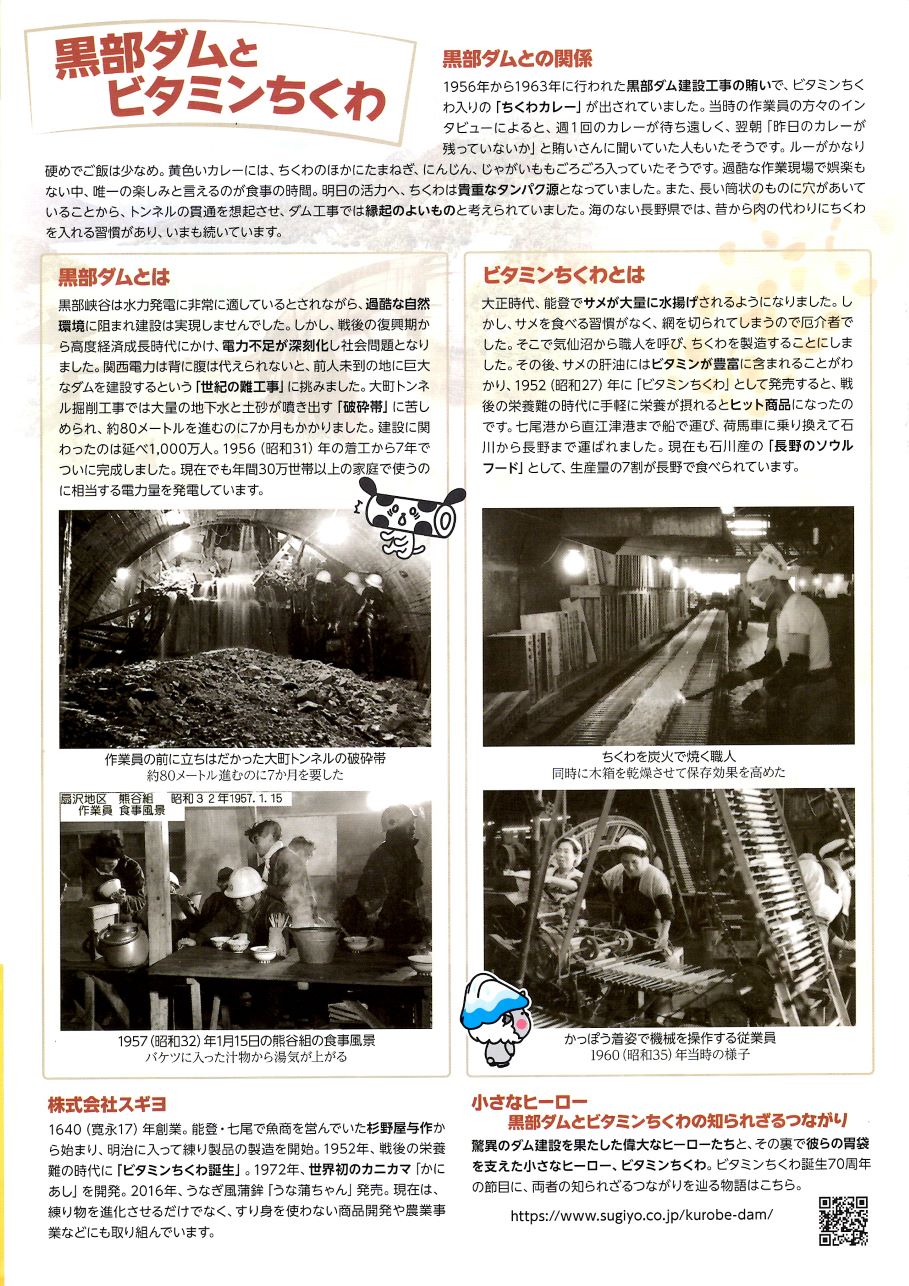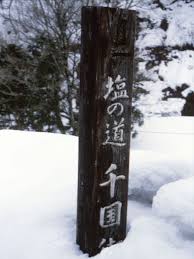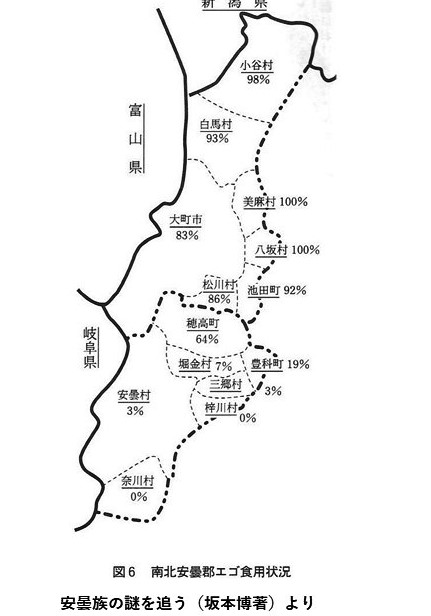The 120km long Chikuni- Kaido(road) was an old highway and important trading route connecting from the Sea of Japan, passing through Omachi city, to the castle town Matsumoto and Shiojiri town. The meaning of Shiojiri is the "end of salt road". Now, Chikuni-kaido is well-arranged as national routes 147 and 148 along the Japan Railway(JR), Oito-line.
Please remind the old-saying “Present your most important one even to one's rival if he is in need”. Here, of course the most important one is 'Salt'.
In times of old civil war, Sengoku era, the salt and marine products were transported via Salt road. We had two famous military commanders; Kenshin Uesugi and Shingen Takeda. They are rivals upon the civil war. Uesugi's territory was situated near the Sea of Japan, while Takeda's territory was not connected to the sea. Takeda has no way of getting salt other than transferring it from the Sea of Japan. An old story tells that Uesugi presented salt to his great rival Takeda even in the middle of battles. The salt road played an crucial role in sending the salt. On this age, our Nagano prefecture was called as Shinano province and is in between Uesugi and Takeda territories. The salt road is the invaluable lifeline not only for Takeda but also for us.
We are not sure if above story is the historical fact or not, but it is true that many seafood, fishes and processed ones have been transported from the seashore area probably by horse-load or carrying on man's shoulder. These caravans have also carried back many products such as hemp and cotton clothes, charcoal and Kozo fiber, paper mulberry, in summer by horse-load and in winter by shoulder. For the new year's celebration, Japanese yellowtails are also carried on this road, which is the special fish that caught at the Bay of Toyama province in winter. The northward 80km from Omachi-town is the rugged mountain pass and has heavy snow in winter. It seems extremely-difficult for the caravan to transport heavy salt packs and carry back many mountain products in return.
Chikuni-Kaido extends along the fossa magna. This also corresponds to the line that separates southwest and northeast Japan by Hida-mountains, being called as North Alps Japan. Himekawa river is famous of producing jadestone and also flows along the fossa magna. Himekawa jadestone had the high quality and has spread over Japan in Jomon-era, which started approximately 15,000 B.C.to 1000 B.C or more recent termination.
Do you know 70% of the "Vitamin Chikuwa" is sold and consumed in Nagano Prefecture, though "Vitamin Chikuwa" is produced in neighboring prefecture Ishikawa, which suffered the disasters caused by Noto-earthquake. Sugiyois the company famous for its production.

According to Sugiyo's website, mass production of chikuwa made from oil sharks began in 1923, and "Vitamin Chikuwa" was commercialized in 1952. The name of vitamin-chikuwa refer to the enrichment of vitamins A and D contained by oil shark liver oil. To keep it fresh during the transportation, salt was put in the holes in the chikuwa and packed in a wooden box for easy handling.
Since Nagano prefecture is landlocked from the sea, a set product with salt has well-accepted from Nagano consumers who suffered from nutritional deficiencies after the war II.
The movie "Kurobe no Taiyo" was famous for its story about Kurobe Dam construction, which took seven years to complete since 1956. This difficult construction, which involved a total of 10 million people, became known nationwide when the movie "Kurobe no Taiyo" was released.
The long cylindrical hole of Vitamin Chikuwa reminds one of a tunnel, and Vitamin Chikuwa Curry was a favorite food among the workers as a lucky food.
This food also raised the profile of "Nagano Prefecture's soul food: Vitamin Chikuwa".
Here too, the "Salt Road" plays an important role, helping in building strong bonds between the Noto Peninsula, Ishikawa prefecture and Shinshu (Nagano Prefecture). Sugiyo company stood up after the serious damage suffered from the Noto Peninsula earthquake disaster and has become a symbol of recovery.
We, the people of Nagano Prefecture, are working hard to consume "Vitamin Chikuwa" in the hope that we can be of some help. This is also the 70th anniversary of the birth of Vitamin Chikuwa, and we would appreciate your cooperation.

Archaeological records tell us that there are many ruins spread around three Nishina lakes: Aoki, Nakatsuna and Kizaki lakes, which situates at our Omachi town and had born by damming up the upper stream of Himekawa river in an old time. These ruins are traced back to Jomon era. In these ruins, you can see the obsidian arrowhead, knives and jade implement, probably used as a hunting tool or ornamentals. The jadestones are the product at Himekawa river, but the main production place is far from three lakes and closer to the Sea of Japan. The obsidian implement is famous of its production at Wada pass, a bit far from Nishina lakes but still in the same Nagano prefecture. Both stones are known as having very nice quality and are found all over the Japanese Jomon ruins. These facts suggest a wide communication and trading action by Jomon peaple. The existence of salt road can be traced back to Jomon era, at least further older than our expectation from the Uesugi and Takeda story.
Do you know the word, Shinano-Azumi-zoku? Shinano-Azumi-zoku is the word for the people who migrated from Kyushu district and settled in Shinano province, at around the present Azumino city. Azmi-zoku is believed to be a descendant of boat handling people who engaged in the trading around the sea between Kyushu island and Korean peninsula. Why and when they came Azumino area is a mystery, but it is true that Azumi-zoku governed this area after their settlement presumably at around A.D. 500s .
There are many hypotheses how and which route they selected to come: Kyushu to Seto Inland Sea through Kinki area to Azumino as a south route, Kyushu to Sea of Japan by ship through the salt road as the north route. Yet, the northern route is a big interest for me.
 One of the facts emphasizing the northern route based on the eating habit of "ego" or "igo", which made of sea weed and processed to a jelly-like ager. Unlike sweet jelly, “ego/igo” is eaten with soya source or sour soy paste. The same is eaten by northern Kyushu people named as "okyuto". No other people eat "ego/igo" or "okyuto" in Japan. Furthermore, the "ego/igo"-eating habit is rather limited even in Shinano province: the distribution is from Sea of Japan to a part of Azumino area along the salt road. Azumino area can be divided roughly into two, Hotaka and Toyoshina, according to the old town division. Almost all people of Omachi-city eat "ego/igo". Hotaka people also eat this cook, however only half of Toyoshina people eat it. In the native Mtsumoto people, in turn, absolutely do not know nor eat, except those who migrated from the “ego/igo” eating area. This fact may support the northern route hypothesis. If they come by southern route, how do you interpret “okyuto” eating cline.
One of the facts emphasizing the northern route based on the eating habit of "ego" or "igo", which made of sea weed and processed to a jelly-like ager. Unlike sweet jelly, “ego/igo” is eaten with soya source or sour soy paste. The same is eaten by northern Kyushu people named as "okyuto". No other people eat "ego/igo" or "okyuto" in Japan. Furthermore, the "ego/igo"-eating habit is rather limited even in Shinano province: the distribution is from Sea of Japan to a part of Azumino area along the salt road. Azumino area can be divided roughly into two, Hotaka and Toyoshina, according to the old town division. Almost all people of Omachi-city eat "ego/igo". Hotaka people also eat this cook, however only half of Toyoshina people eat it. In the native Mtsumoto people, in turn, absolutely do not know nor eat, except those who migrated from the “ego/igo” eating area. This fact may support the northern route hypothesis. If they come by southern route, how do you interpret “okyuto” eating cline.
There are many other mysteries, yet Shinano Azumi-zoku suddenly disappeared from the history. The ruler of Azumino is altered by Nishina family presumably at around A.D. 800s , Heian era, including Omachi area.
Our homeland Yashiro village of Omachi is the place where Nishina family set their residence at first and built Nishina Shinmeigu shrine as the guardian deity. Akiko Nishina , who is a famous actress now,is said to be the descendant of Nishina family. There was another historical person, Morinobu-Goro-Nishina, who worked under Takeda in Sengoku era. After the ruin/perish of Nishina family, the governor changed to Ogasawara in Edo era, the area along the salt road was crowded with traders staying and opening 'salt markets'.
Reference:
A series of books written by Dr. H. Sakamoto such as "The roots of Shinano-Azumi-zoku" (2003, Kindaibungeisha in Japanese).
Ancient Azumino written by S.Nishina(1972,Yanagisawa-shoen in Japanese)
Azumizoku:http://www9.wind.ne.jp/fujin/rekisi/zakki/azumino/azumizoku.htm
There are still many names related to the day of the market, such as Itsuka-machi (district of day 5 market), Toka-machi (district of day 10 market) and so on. We call candy market as 'Ame-ichi', where 'Ame' means candy and 'ichi' means market. The reason why the salt replaced by candy is obscure, but one folklore told that the salt market had started when another enemy of Takeda (Imagawa and Houjo) prohibited salt trading in Takeda's territory almost 430 years ago. That is what evoked the story of 'Uesugi had presented salt to Takeda'. And the 'Salt market' was replaced by the 'Candy market' in the early Edo age probably due to the no speciality of salt selling yet. January 11 is one of the memorial days for Matsumoto people because the first salt had arrived. And one month later, February 11, is the day of Ame-ichi now in Omachi. Thus, the day of Ame-ichi is fixed town to town along the extention of salt road.